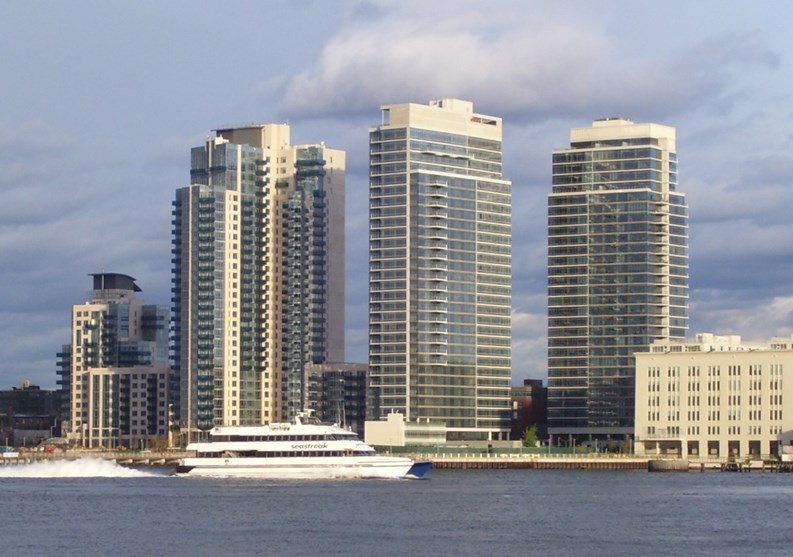Williamsburg suffers from multiple personality disorder. Just one subway stop away from Manhattan in the Brooklyn neighborhood, you’ll find a large Hasidic Jewish community, a glut of ethnic enclaves, including Polish, Puerto-Rican, Dominican and Italian, a working-class neighborhood, and a hipster theme park (hipster: by definition, is one who possesses tastes, social attitudes, and opinions deemed cool, by cool people).
Thanks in part to a hyperactive gentrification process that spurred an explosion of theater, art and music venues, not to mention a culinary scene that rivals Manhattan, Williamsburg has gone prime time. The sitcom 2 Broke Girlschronicling the lives of two struggling waitresses at a Williamsburg diner who aspire to open a cupcake shop, debuted on CBS during the 2011-12 television season. Storylines have included a fight over a Strokes T-shirt in a Williamsburg Goodwill thrift shop and a ‘90s-themed party to repay a student loan debt.
A Vibrant Lifestyle
With its mish-mash of cultures, numerous cafes, restaurants, boutiques, vibrant art scene and close proximity to Manhattan, Williamsburg is considered to have some of the most desirable real estate, outside of New York City. Williamsburg borders Greenpoint to the north, Bedford-Stuyvesant to the south, Bushwick and Ridgewood, Queens to the east and the East River to the west.
Historical References
In 1638, the Dutch West India Company purchased the land that is today’s Williamsburg from the local Native Americans. The area was comprised mainly of farmlands, rolling hills and meadows, surrounded by bodies of water.
Around 1792, Richard Woodhull, a wealthy New Yorker and operator of a ferry to Manhattan, purchased 13 acres near what would later become Metropolitan Avenue, with hopes of attracting wealthy industrialists to suburban life and relief from overcrowded conditions in Manhattan. Mansions built by Manhattan’s elite soon began popping up along the shoreline.
When the Erie Canal opened in 1825 it turned New York into “America’s preeminent seaport.” The Canal’s connection to markets in the Midwest resulted in a manufacturing boom in Williamsburg. The shore that was once home to wealthy New Yorkers was soon filled with factories, sugar warehouses, oil refineries, printing facilities and cast-iron manufacturing companies. Along with the industrial boom came smoky pollution, smog and bleak, dirty streets, and a fresh wave of German and Irish immigrants looking for jobs.
A Tree Grows in Brooklyn
The opening of the Williamsburg Bridge on December 31, 1909 was significant. The connection of the Lower East Side to Williamsburg brought in a flood of Jewish, Italian and Slavic immigrants. The population of the area swelled to over 250,000. By 1917, Williamsburg was the most densely populated area in the greater New York area, with 5,000 people crammed into a city block.
Betty Smith’s 1943 novel “A Tree Grows In Brooklyn” depicting the hard knock story of an Irish-American family struggling to survive in the early 1900s in a dilapidated Williamsburg tenement whose children attend a squalid, overcrowded public school was right on the money. By the 1930s, Williamsburg was a poverty-ridden slum.
In 1938, after two years of construction, and millions of dollars, the low rent Williamsburg Houses opened under the auspices of the Housing Division of the Public Works Administration (PWA.) The 20, four-story, residential buildings occupied 12 city blocks and was the country’s first public housing development for low income families. New York City Mayor Fiorello LaGuardia eagerly endorsed the project.
The Makeover
As Soho became gentrified in the 1980s and priced artists out of the pricey neighborhood, many left Manhattan for Brooklyn in search of large loft spaces, cheap rents and easy New York City access. The artists and bohemians eventually landed in Williamsburg. Underground theater, music and unlicensed performance spaces operating out of abandoned industrial buildings soon opened. By 1996, Williamsburg had an artist population of 3,000 and the numbers were growing.
From Boom to Bust?
On May 11, 2005 the New York City Council passed a bill spearheaded by Mayor Michael R. Bloomberg, rezoning Williamsburg’s most desirable sections—the blocks surrounding the Bedford Avenue subway station—for residential construction and the revival of the waterfront. Builders were now able to build as high as 40 stories and receive massive tax breaks, as long as a portion of their building was dedicated to low-income housing.
The construction of glass and steel high-rise condominiums and sleek loft-like spaces were erected at break neck speed, taking the place of vacant industrial factories, humble row houses, trash-strewn lots and dreary storefronts.
Within six months of the passage of the rezoning bill, 130 new construction projects were in the works. Developers braced themselves for a stampede of young professionals willing to pay Manhattan prices, to invade the area.
The recession of 2008 stopped the high density of new construction projects in its tracks. The following year, Fannie Mae, the country’s most influential mortgage lender, implemented a new policy requiring that buildings must be 70 percent (previously 50 percent) in contract before guaranteeing mortgages and the condo boom went bust. Williamsburg today is bustling with cafes, art galleries, swanky restaurants and hipsters galore and is the home of actress and singer Zoe Kravitz and British model and socialite Peaches Geldof, but you’ll also find numerous half-completed buildings, mud pits where luxury condos were supposed to be built, foreclosed buildings and near empty amenity-laden buildings.
Christy Smith-Sloman is a staff writer for The Cooperator.





Leave a Comment